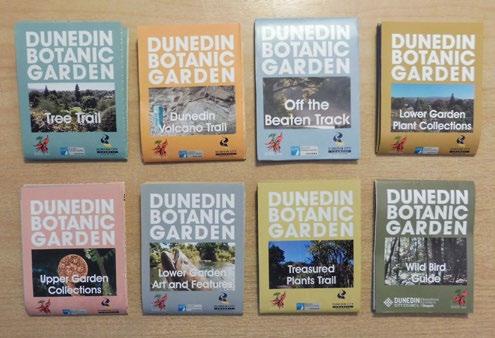
3 minute read
Pocket-sized brochures for visitor convenience
28 Clare Fraser, Adult Education, Dunedin Botanic Garden
Traditional brochures aren’t necessarily designed for outdoor use. Visitors to botanic gardens contend with wind and rain. They also need to keep their hands free to drive wheelchairs and pushchairs, manage children or just hold sunhats in place. Dunedin Botanic Garden’s new fold-up brochures allow visitors to carry unused brochures in their pockets, then pull them out again, fully intact.
It all started when we redesigned our main map brochure. Most of the botanic garden is on the slopes of a hill so the question of accessibility came to mind. For people in wheelchairs and pushchairs we can’t change the terrain or even do very much to change tracks. However, some spots are innately more accessible than others so we decided we can provide information to help visitors know which they are.
Wheelchair users were contracted to travel every track and calculate a rating of either easy, medium or hard. It turned out that some spots on the top of the hill or even its more gentle slopes are fully accessible to all. This was a pleasant surprise for a wheelchair user at the brochure launch who said she’d thought that since her accident she’d never be able to visit the upper garden again.
Consulting people who use their hands for transport prompted the idea that a fold-up, pocket-sized brochure would be extremely useful. And, as is often the case with accessible infrastructure, it also offered practical convenience for all visitors.
So we were off.
Visitors had been showing interest in the garden’s specimen trees so a pocket-sized Tree Trail was developed around 50 or so trees. Next, a staff member met a friendly geologist in a pub and the idea for the Volcano Trail was born, following existing tracks up the side of an ancient volcano. The geologist, from GNS Science, provided expert technical advice and was a natural educator, open to seeing the facts interpreted into a user-friendly form. The trail is a real hit, with 3000 brochures moving in the first six months. The new suite of pocket-sized outdoor-friendly brochures developed for Dunedin Botanic Garden.

Existing brochures were old and needed to be reworked into a new format. It was a case of looking afresh at what needed to be said. Some material from the old brochures was edited out and new material was included. Five of the old brochures were condensed into one new one.
The trail is a real hit, with 3000 brochures moving in the first six months. Existing brochures were old and needed to be reworked into a new format.
Partnerships continued to bear fruit. The local social history museum, Toitu, approached the botanic garden requesting permission to host a tour of edible native plants. It was to be based on the book recently produced by Rob Tipa, Treasures of Tane about traditional plant use by Kai Tahu, the local Maori tribe. I had been aware of our gap in visitor information on this topic so saw the request as an opportunity to fix this, the eventual result being a Treasured Plants Trail with Rob kindly providing full access to his text and photos.
A similar arrangement was made with the local branch of Birds New Zealand to produce the Wild Bird Guide, covering 27 native and introduced birds commonly encountered by visitors. Pleasingly, we were starting to interpret the wider botanic garden ecosystem – the geology and birds as well as the plant collections.
The trail-based brochures offer a cost-effective way of filling gaps in the system. There is only one paid visitor-focused staff member and no children’s education officer, hence, a Children’s Play Trail is about to be launched. It taps into existing sites, pulling out their potential for child visitors and repackaging them into a trail on paper. Rather than taking a traditionally informative educational approach, the trail encourages children to experience the place screen-free through interactive, experiential, even ‘mindful’ play, with the philosophy that developing a love of a place and of nature leads to self-motivation for future learning.
Research for an Edibles Trail is underway and the BGANZ conference provided an opportunity to find out how other botanic gardens manage the potential problem of harvest. Another possibility to develop as a result of the 2019 BGANZ conference is a Silent Space Trail, again a mere repackaging of existing assets into a form easily accessible to visitors.
Ease of access for all is a major aim for a botanic garden and these pocket-sized brochures help meet that need.
* Presented at the 9th BGANZ Congress










